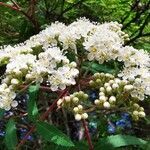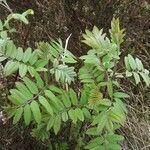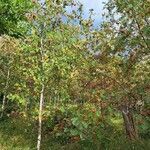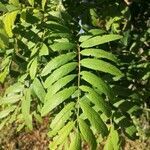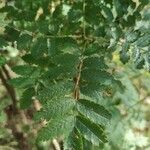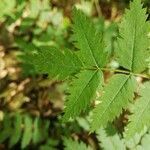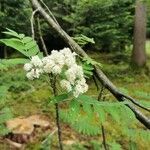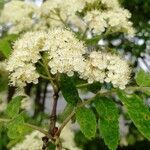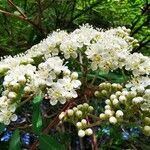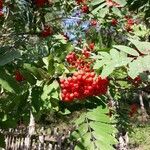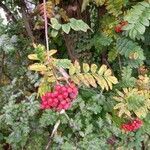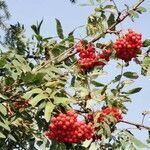Tree up to 8-(12) m high, usually with an erect trunk and spreading branches; young shoots pilose, sometimes densely so, but soon becoming glabrate. Buds large; outer scales glabrous, purplish, inner scales densely covered with white hairs towards apex. Lvs imparipinnate with up to 8 pairs of leaflets; petiole 20-35-(45) mm long, green or brown to purplish, pilose, but hairs deciduous, sometimes with stalked glands; leaflets (excluding smaller ones near base) narrowly oblong or oblong-elliptic, sometimes lanceolate-elliptic, (20)-30-50-(60) × 8-20-(25) mm, obtuse to acute, ± sessile, deep green and glabrous or finely hairy above, paler and finely to densely pilose below, serrate along whole length or sometimes in upper ⅔ only; leaflets of juvenile plants and suckering shoots narrowly elliptic to elliptic-ovate, deeply and jaggedly toothed; stipules ± deciduous, small, acuminate. Infl. drooping, up to c. 120 mm across; pedicels and branchlets white-villous, becoming glabrate by fruiting. Sepal lobes broadly triangular, 0.6-1.3 mm long, obtuse, white-villous, at least at base, sometimes glabrous in upper part; margin with several short glandular teeth. Petals 3-4.5 mm diam., ± orbicular with abbreviated claw, white. Fr. depressed-globose, sometimes ± oblong-obovoid, 5-10 mm diam., deep orange to scarlet, sometimes crimson, glossy.
More
A small tree which loses its leaves during the year. It grows 12-15 m tall and spreads 4.5-7.5 m wide. The bark is grey and smooth. The leaves are alternate and compound. The leaves are green, but whitish underneath and divided along the stalk. There are 9-17 leaflets. These are 3-5 cm long. There are teeth along the edge. They are usually hairy on both sides. The flowers are white and scented. They are on hairy stalks. The fruit are bright orange or red berries. They are large and 10-12 mm across. They occur in round topped clusters.
Tree to 10 m, the younger parts ± white-villous, not glutinous; lfls oblong, 3–5 cm, acute to obtuse, sharply or bluntly serrate; pet orbicular, 4–5 mm, about equaling the stamens; fr ca 1 cm thick; 2n=34. Native of Europe, often escaped from cult. and even appearing as native in our range. (Pyrus a.)
The leafy shoots are eaten. The ripe fruit can be made into jelly which is eaten with game meat. They are eaten after the first frost. Also for jam. They are also made into a drink. They are high in Vitamin C. The dried fruit are ground into flour to make bread. Leaves and flowers are used to adulterate tea. CAUTION: The fruit can be poisonous if eaten raw.
